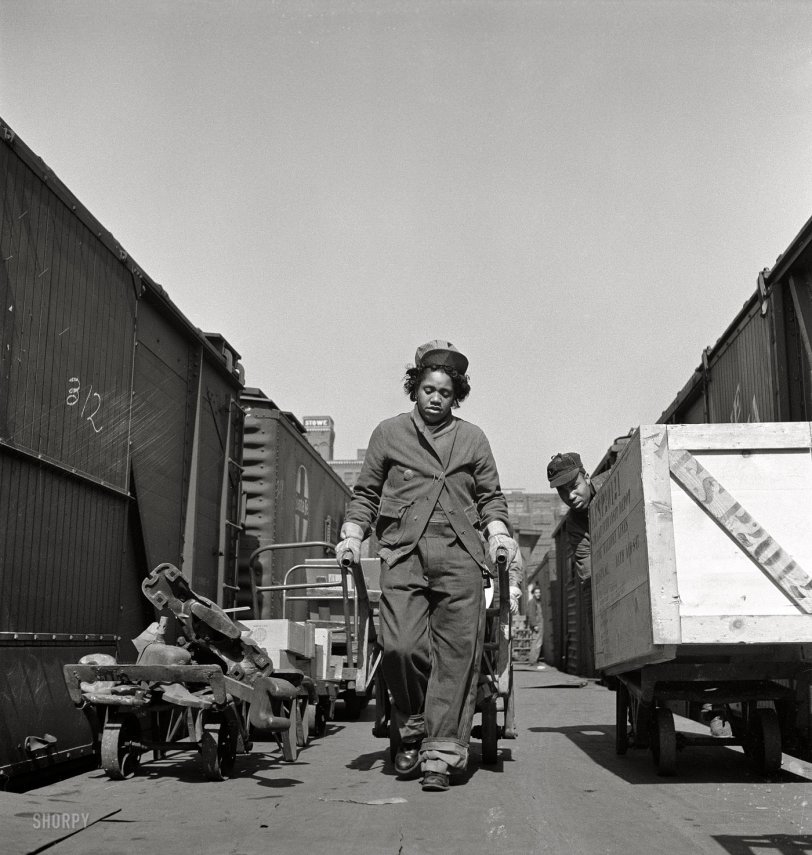


Framed or unframed, desk size to sofa size, printed by us in Arizona and Alabama since 2007. Explore now.
Shorpy is funded by you. Patreon contributors get an ad-free experience.
Learn more.

- Freeze Frame
- Texas Flyer wanted
- Just a Year Too Soon
- WWII -- Replacing men with women at the railroad crossing.
- Yes, Icing
- You kids drive me nuts!
- NOT An Easy Job
- I wonder
- Just add window boxes
- Icing Platform?
- Indiana Harbor Belt abides
- Freezing haze
- Corrections (for those who care)
- C&NW at Nelson
- Fallen Flags
- A dangerous job made worse
- Water Stop
- Passenger trains have right of way over freights?
- Coal
- Never ceases to amaze me.
- Still chuggin' (in model form)
- Great shot
- Westerly Breeze
- For the men, a trapeze
- Tickled
- Sense of loneliness ...
- 2 cents
- Charm City
- What an Outrage
- Brighton Park
Print Emporium
Millie Williams: 1943

March 1943. Kansas City, Missouri. "Mildred Williams, one of several women freight handlers employed at the Atchison, Topeka, and Santa Fe depot." Medium-format negative by Jack Delano, Office of War Information. View full size.
Stowe Building, Kansas City
That's the Stowe Building next to her shoulder.

Millie is beautiful
After all the critiques of women's attributes that I've seen in these comments, I'd just like to say that I believe Millie was a woman to be reckoned with, and given the advantages of education and wealth would surely have surpassed them all.
That's a heavy load.
If memory serves, the type of hand-truck Ms. Williams is pulling was called a stevedore, and was named for the cargo loaders on ships docks. I used to use one back in the 70's for moving 55 gallon drums. It must have weighed 100 pounds by itself, and although it could be easily balanced, there was still a lot of weight to by pulled. Couple that with the fact that those wheels are solid steel, and you've got the makings of some stiff muscles by days end. Today they are made of formed aluminum with inflatable tires and weigh 1/10th what they did. Today, her partner would be guiding an electric pallet jack. or driving a fork lift.
Modern times.
I last worked on a LTL freight dock in the 80s and we were still using the style of two-wheeler in the photo then. They are clumsy things to use when facing the "right" way and the way Millie is using one even more clumsy.
Once loaded correctly, you'd be surprised how easy you can wheel a crate around like the fellow on the right is doing though.
There are several "Mildred Williams" of the appropriate age (88-95) listed in the KC phone book. If this one is still around and one of those, let's hope she Googles her name someday and arrives "here" for a nice surprise.
Action shot
The simple composition of this photo is strong and dramatic. Notice how the "V" lines of the freight-car roofs direct the eye to the subject of the photo, Miss Mildred with her hand-truck.
The open sky overhead could be seen to represent escape, freedom, or even heaven, but Miss Mildred, caught in this photo, is forever earthbound, toiling along in the tunnel between the train cars to this very day.
I doubt if the photographer thought about all that when he snapped the photo. He just looked through the viewfinder with his photographer's eye and thought, "That looks good."
Freight couture
Mildred has coveralls on over her street clothes. See left leg and waistband. Just love this site. Father-in-law was with ATSF for 40 years an this is the way he dressed.
Dickies
I'm betting these are actually men's jeans Mildred is wearing. Very stiff and uncomfortable. Check out the safety pin holding her sweater closed.
Youths of today have no idea how physically hard their grandparents & great-grandparents worked.
Muscles of steel
She would be one tough woman. Nobody had better try to mug her on her way home. She would just lift them off the ground, toss them into a corner and beat the stuffing out of them!
Dave, thanks for showing women in non-traditional roles from way back when.
Backbreaker
My dad tells the story of when he was in high school (around 1943) of helping my great-uncle unload a freight car full of red brick that he was building a house with.
It had to be unloaded in one afternoon. Dad is 83 now, and says that was the most bone tired he ever was. He says pulling slabs in a sawmill was a close second, though.
Rough Job
This is a service known as LCL(Less than Carload Freight), a business practice discontinued by the railroads by the late 1960's. Single boxcars were loaded with freight from several different shippers all sending to the vicinity of a certain area, and the cars were then unloaded at centers like this one, the freight sorted and then put on trucks to the final destinations. This service was very labor intensive and therefore unprofitable; railroads lost money on it even during the war years. These days rail customers have no choice but to ship in bulk, one car to a customer.
All I can say is that she must have been one hell of a tough woman, working probably 48 hours a week or more dragging freight off those cars. The items handled could have been anything, and most were probably heavy, like those solid steel pieces on the cart to her right.
























On Shorpy:
Today’s Top 5